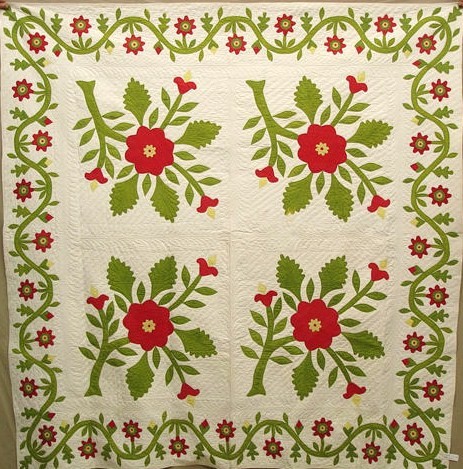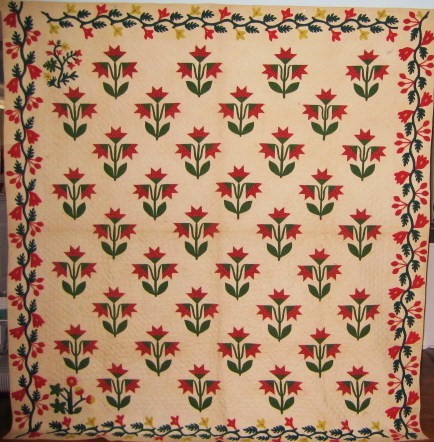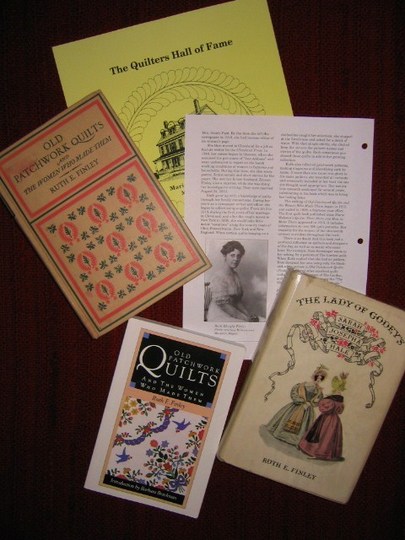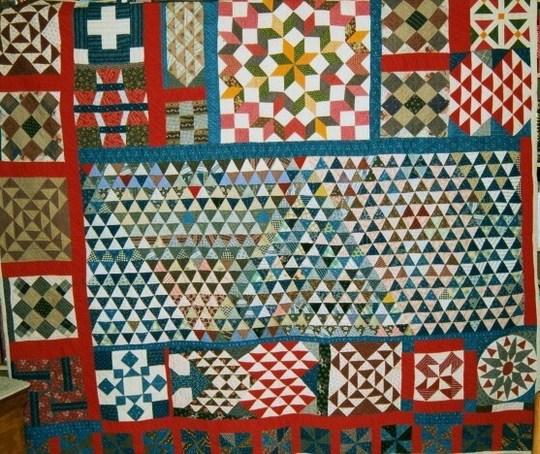
Red Green 4-block Quilt, possibly 1850_photo source Internet Auction06
Ruth Finley: Quilt Collector, Journalist, Feminist
by Karen Alexander
"At the time of her death, Ruth Finley was eulogized for her career in journalism, her feminist activities and her political and civic work; but today she is widely remembered for a single achievement, her book about quilts."
Barbara Brackman, from her Introduction to the 1992 reprint of Finley's Old Patchwork Quilts and The Women Who Made Them by EPM Publications.
Ruth Bissell Ebright Finley (1884-1955)
of Akron, Ohio and Long Island, New York
1979 Honoree of The Quilters Hall of Fame
Ruth Ebright Finley's Old Patchwork Quilts and The Women Who Made Them, first published in 1929, was only the second book to be written dedicated solely to the quilt, the first being Marie Webster's book Quilts: Their Story and How to Make Them (1915) . Ruth Ebright was born in Akron, Ohio, in 1884 of parents who both had college degrees, something still rare for the times. Though Ruth did attend some college, instead of graduating, she chose to travel for three years all the while practicing her writing skills. Upon returning to Akron, she landed her first job at the Akron Beacon Journal in 1907 and received her first by-line when she landed a rare interview with Mrs. Henry Ford. In 1910 she moved on to The Cleveland Press and wrote feature articles under the name Ann Addams. It was while working as a housemaid on an undercover story about working conditions for lower-income women that she met her future husband, also a journalist. Ruth feared her "missus" was getting suspicious because all her previous maids had had a "young man" calling on them and Ruth wanted to destract her from any questioning, so she asked the boss to send someone over. The boss chose Robert Finley, though not without some protest on Finley's part. Within a few months the serendipitous meeting ended in a marriage with her boss taking credit in print in the newspaper for bringing them together!

Lily as seen on eBay November 2008
Quilts had been a part of Ruth's life since childhood and she had developed a keen interest in them early on. In 1915, as she began to take vacations by automobile, often with friends, she got in the habit of stopping to investigate whenever she saw quilts hanging on a line, using the excuse that she was in need of a glass of water. Finley later wrote, "The amount of water I have drunk in the cause of quilts would float a battle ship." Being a journalist, she naturally sought the story behind the quilt, getting her material from primary sources as she traveled about the countryside. Finley was the forerunner to Florence Peto, whom I wrote about last month (read the article here).
Both women made a determined effort to capture the stories, not just collect quilts. Finley's book came out 10 years before Peto's book. Both were adventuresome and devoted to the study of fabrics and the searching out of a quilt's history.
The 1920s and 30s spawned still another resurgence of interest in Colonial Revival and Americana, and the creation of museums - such as Colonial Williamsburg in 1927, Greenfield Village in 1929, and Winterthur in 1930 by members of prominent industrial families - kicked this latest revival into high gear. Ruth herself had grown up in a family with great respect for history and their own colonial heritage. She was the genealogist of the family, keeping meticulous notebooks; became a member of the DAR and visited often relatives still living in Litchfield, CT, all the while adding to her research.
As a result of her extended family, Finley had access to many generations of family letters, diaries, account books and legal documents, some dating as far back as 1730, as well as old newspapers, and she drew heavily upon this material for the writing of Old Patchwork Quilts. She also illustrated the book with a number of family quilts, along with others that she borrowed. The book was 16 years in the making and made an enormous contribution to the history of the quilt.

Photo by Karen Alexander
In the process of working on her first book, Ruth inadvertently stumbled across the subject matter for her second book when she discovered Sarah Josepha Hale, the first woman editor in America "who made Godey's Lady's Book the forerunner of the modern women's magazines." Hale was the woman who petitioned Abraham Lincoln to make Thanksgiving a national holiday and wrote the poem "Mary Had A Little Lamb." She was also a fierce advocate of women's rights but was "far too clever to antagonizing her audience by openly campaigning for them." Instead, "she played upon their sentiments," Finley wrote, "to introduce revolutionary ideas in lady-like editorials-with signal success." The Lady of Godey's: Sarah Josepha Hale, Finley's second book, is a fascinating read of how one woman began to shape the minds of American women through the first widely distributed women's magazine. Though the book is out of print, it is well worth tracking down a copy. I treasure my copy.
Like Florence Peto, Finley also bought and sold quilts throughout her life. Perhaps the most famous quilt from today's standards that she once owned was the Lincoln Quilt by Elizabeth Keckley, the ex-slave who sewed for Mary Todd Lincoln. Finley died September 24, 1955. In January 1967, family members held a tag sale at one of the family farms in Ohio. Ross Trump, who handled the sale, reported in an interview to quilt historian Ricky Clark that few of the quilts sold. Obviously the late 20th century quilt renaissance had not yet begun in earnest if only a few quilts sold that day. Eventually Mr. Trump purchased several of the quilts himself, including the Lincoln Quilt. In the mid 1990s he donated the Lincoln Quilt to the Kent State University Museum in Ohio, which just happens to be where my father taught for 30 years. Small world.

Rockingham Co Sampler 1180-1910. Photo courtesy of Karen Alexander
Both Ruth Finley and Florence Peto were forerunners of the many quilt historians that would emerge in the late 20th century quilt revival thanks to the creation of the American Quilt Study Group by Sally Garroute and those pioneer AQSG members who attended the first seminar in 1980.
Karen B. Alexander
The Quilters Hall of Fame
Past President
Sources:
- (1) Ricky Clark, "Ruth Finley and the Colonial Rival Era" in Uncoverings 1995, ed. Virginia Gunn (San Francisco, CA: American Quilt Study Group, 1995)
- (2) Barbara Brackman, from her Introduction to the 1992 reprint of Finley's Old Patchwork Quilts and The Women Who Made Them (McLean, VA - EPM Publications, 1992).
- (3) Virginia Amling, "Ruth Finley" in The Quilters Hall of Fame, ed. Merikay Waldvogel and Rosalind Webster Perry (Marion, IN - The Quilters Hall of Fame, 2004)




.jpg)


